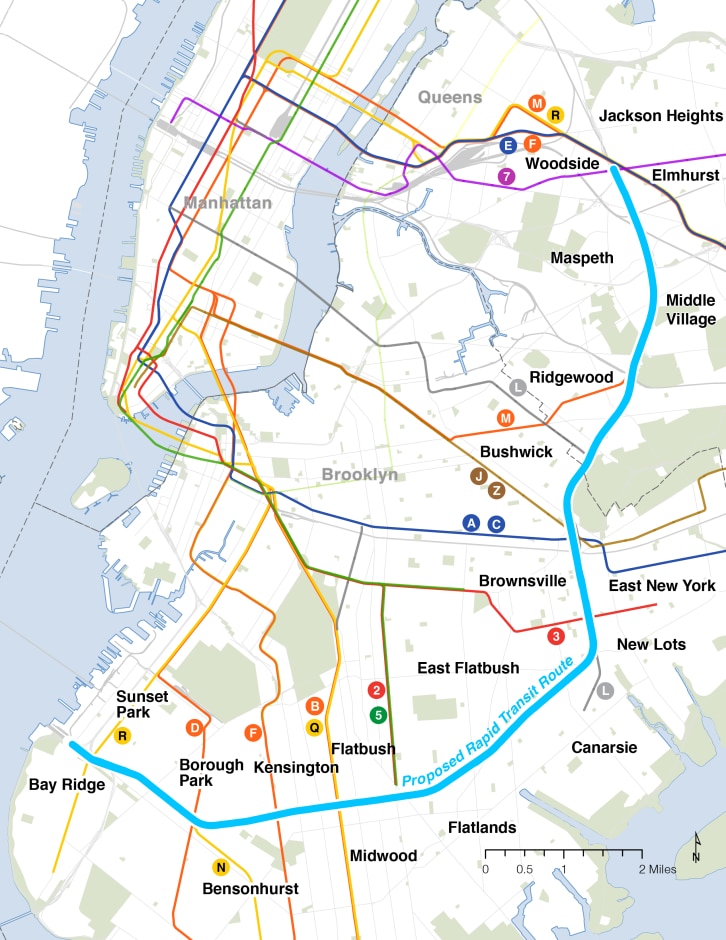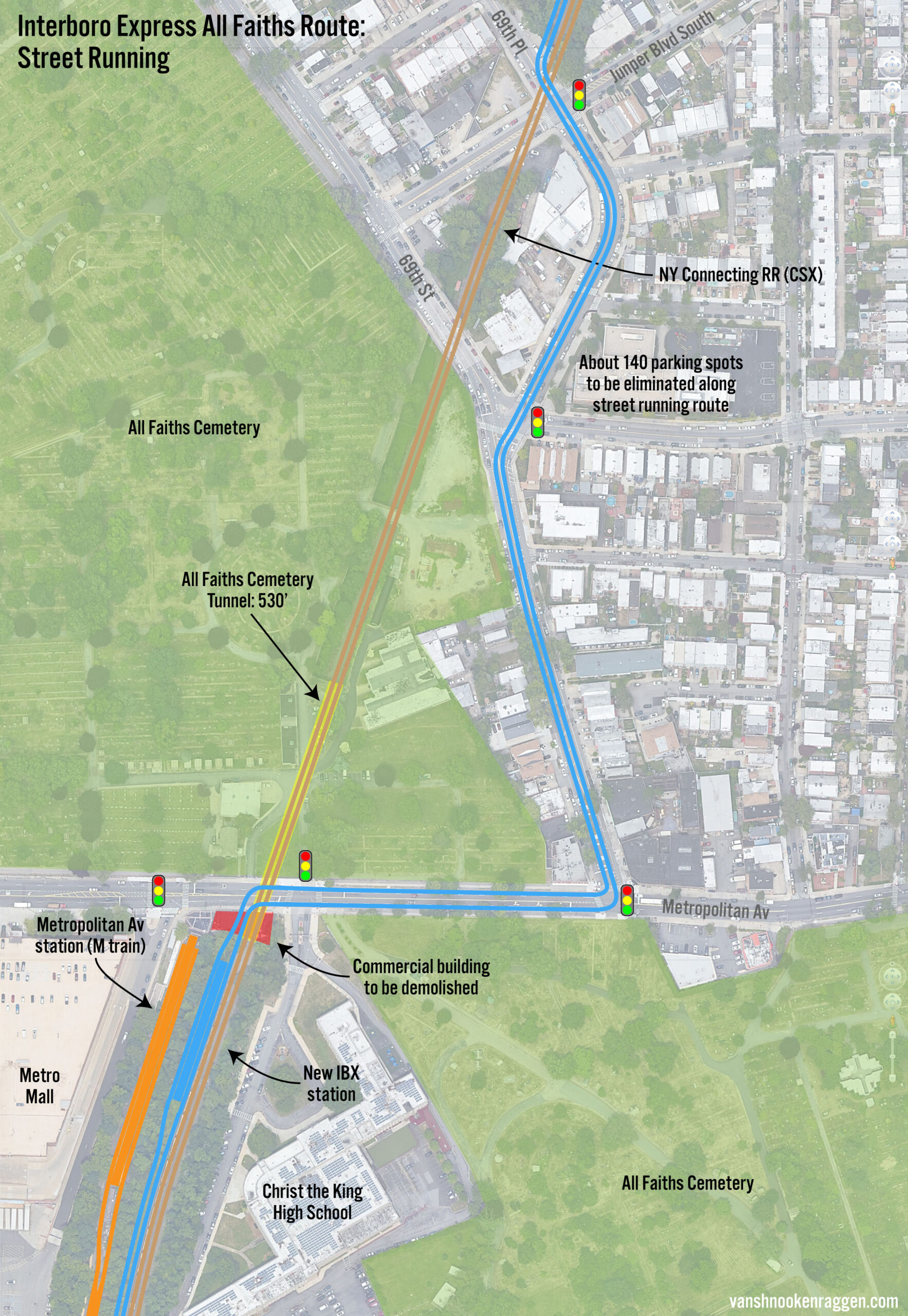In early 2022, New York governor Kathy Hochul announced her plan to build a train connecting some of the outer boroughs of New York City to each other, calling it the Interborough Express. The IBX announcement was a follow up to a feasibility study initiated in 2020 to see if there could be a new train line connecting Bay Ridge, in southwest Brooklyn, to Astoria, in northwest Queens. This plan would create a transit capacity connecting the outer boroughs without passing through Manhattan, which is currently necessary, unless you can stomach waiting for the (short) G service.
This plan minorly resembles the New York Regional Plan Association's decades-old idea for the Triboro, a train that would connect Brooklyn, Queens, and the Bronx. The notable exception of the IBX is that it does not connect to the Bronx.
 |
| The proposed route for the IBX |
The IBX will use existing freight right-of-way, but operate on its own tracks along the freight trains. The orbital nature of the train proposal naturally draws parallels to orbital systems in other cities and the type of trains that they use.
First, a diversion. There are a few distinct types of passenger train. There is heavy rail, which is traditional subway cars like those used by the New York subway. Heavy rail can also describe "commuter rail," similar to systems like the Northstar of the Twin Cities or other passenger rail like Amtrak. Not all of these heavy rail systems are created equal — for example, New Jersey's PATH trains are heavy rail but are smaller than NYCT trains. There is also light metro, which refers to lower capacity systems (still quite high capacity) such as Vancouver SkyTrain, which operates on the same technology as the Detroit People Mover. There are also light rail systems, like the Twin Cities METRO, the Boston Green Line, Philadelphia's SEPTA Trolley, or the Detroit QLine. These systems have lower capacity and can run in the same right of way as cars, or have their own right of way. Because they sometimes have at-grade crossings with pedestrians or vehicles, they are often not automatable like heavy rail subway systems.
The IBX drew parallels to systems like the London Overground in particular because of where and how it would run. While the London Underground is one of the world's biggest rapid transit systems, the Overground is one of its most notable suburban rail systems, and is held up by the aforementioned RPA as a success story. Another notable example is the Paris RER, a circumferential hybrid regional-rapid rail system that serves as an express train when running through the city center.
The IBX was either to be conventional heavy rail, light rail, or bus rapid transit (another type of rail seen in Minnesota, originating in Curitiba and rarely a good choice in high-capacity American situations because of high maintenance and labor costs). In January 2023, Governor Hochul announced that the IBX would be a light rail system. I just learned this today. This is a bit heartbreaking for people who wished that the IBX would be an RER/Overground style regional rail system that served several outer boroughs at a high capacity. Instead, the IBX will be a low-capacity system with 10-minute headways outside peak times and be a shell of the train that it could possibly be.
The question then comes to why would they choose light rail? There are a range of reasons, but the most important reason is that the trains are smaller and commercially available so they will fit in a small tunnel in East New York that cannot be expanded to fit larger subway trains.
To make matters worse, this light rail will have to go under Metropolitan Ave and under All Faiths Cemetery in Middle Village, Queens. The tunnel is currently in active use by freight trains and by the MTA for freight operations, making the tunnel at capacity. The tunnel is an old fashioned cut and cover tunnel, meaning that is basically a hole in the ground that they added a roof to. Instead of expanding the tunnel, the MTA is proposing to have the train come above ground onto rails in the roadway, circumnavigate the cemetery, and then rejoin the freight tracks after the tunnel completes. Conventional rail would not be able to make the tight turns required for this circuitous route.
This is a potentially bad idea. Metropolitan Ave is a very busy street and the only E-W street nearby. Running the IBX in the public ROW would be a major bottleneck on the route. The obstacle to expanding the tunnel on the left, where the IBX would run, is that that would require relocating dozens of bodies as well as the ashes over around 500 people stored in the All Faiths mausoleum. Moving bodies for transit is not unheard of. The M train station is also on that side, and makes for easy transfers with the IBX. The obstacle to expanding the tunnel to the right is that that would require moving other trains onto different tracks.
Here, there are two bad and compounding things. One question that comes up simply fix this problem? They seem capable of fixing seemingly intractable issues by spending billions of dollars like the $7.4B Second Ave Subway extension that is two stations long. In my opinion, I think the MTA could probably solve this problem, they just don't want to. The tools they have at their disposal are limited, and they have to incorporate "neighborhood feedback," which is always overwhelmingly negative. One urban planner I frequently used to read on Twitter explained:
As a side note, the reason NA loves LRTs so much is that it is very suitable to the high-cost, multiple veto points environment of transit projects here: it's malleable, so it can be "adapted" locally depending on the level of resistance from local veto-power holders.



